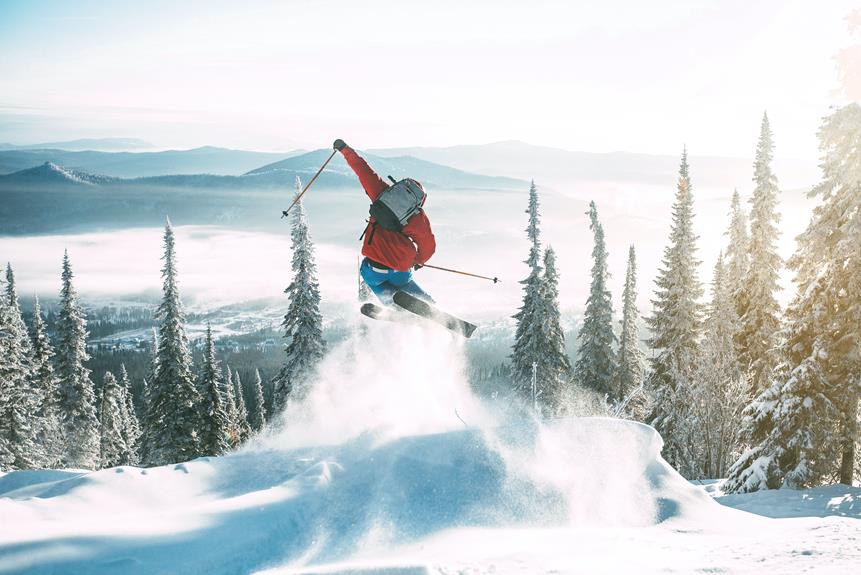How Long Do Skis Last – Essential Tips Inside
Have you ever wondered how long your skis will last?
Picture this: you've been hitting the slopes every winter for the past five years, shredding down the mountains with a smile on your face. But now, you can't help but notice that your skis just don't feel as responsive as they used to. Is it time for a replacement?
In this discussion, we will delve into the factors that affect the lifespan of skis, signs that indicate it's time to say goodbye to your trusty pair, and why considering a new set of skis every ten years might just be worth it.
Get ready to hit the slopes and find out if your skis are up for the challenge!
Factors Affecting Ski Lifespan
Factors affecting ski lifespan include:
- Frequency of use: Skiing frequently can lead to faster wear and tear on skis, while occasional use can extend their lifespan.
- Proper maintenance: Regular waxing and tuning can improve skis' performance and durability.
- Storage conditions: Protecting skis from extreme temperature changes and storing them in a ski bag can prevent damage and prolong their lifespan.
- Skiing style: Aggressive skiing in terrain parks can cause more stress and wear on skis compared to cruising groomed runs.
- Terrain: Skiing on rocky or rough areas can potentially damage skis and shorten their lifespan.
Signs Your Skis Need Replacement
If you notice significant damage or wear on your skis, it may be time to consider replacing them. Over time, your skis will naturally wear down due to the constant friction and impact they experience while skiing. The number of ski days you have had can also affect the lifespan of your skis. Generally, a well-maintained pair of skis can last anywhere from 100 to 125 ski days. However, this can vary depending on the quality of the skis and the type of terrain you ski on.
One of the most obvious signs that your skis need replacement is when you start to notice significant damage or wear on the bases or edges. Deep scratches, gouges, or delaminations can affect the performance of your skis and make them less safe to use. Additionally, if your skis are several years old or have been used extensively, it may be time to replace them. As skis age, the materials can deteriorate, which can lead to decreased performance and stability on the slopes.
Ultimately, the decision to replace your skis should be based on their condition and how they perform. If you notice a significant decrease in performance or if your skis are showing signs of wear and tear that can't be repaired, it's probably time to invest in a new pair. Remember, having the right equipment is essential for a safe and enjoyable skiing experience.
Reasons to Replace Skis Every Ten Years
After considering the signs that indicate your skis need replacement, it's important to understand the reasons why replacing your skis every ten years is recommended. Here are three compelling reasons to invest in a new pair of skis:
- Stay ahead of the game: Ski technology is constantly evolving, with new designs hitting the market every five years. By replacing your skis every ten years, you ensure access to the latest advancements in control and handling. Imagine gliding down the slopes with a pair of skis that offer improved performance and responsiveness. It's an exhilarating feeling that will enhance your skiing experience.
- Cater to your preferences: The latest ski models come in a wide range of shapes and styles, allowing you to find the perfect match for your skiing preferences. Whether you prefer carving through groomed slopes or tackling powder in the backcountry, there's a ski designed to optimize your performance on specific terrains. Treat yourself to a new pair of skis that aligns with your skiing style and enjoy the thrill of tailored performance.
- Unlock the future of skiing: Upgrading your skis after ten years not only ensures you have the latest technology, but also gives you a glimpse into the future of skiing. From innovative materials to cutting-edge designs, the advancements in ski gear can revolutionize your skiing experience. Visit your local ski shop, explore the newest offerings, and be ready to embrace the exciting possibilities that await you on the slopes.
Factors to Consider When Deciding to Replace Skis
To determine when it's time to replace your skis, consider the age of your skis and the condition they are in. Skis have a lifespan of around 5 to 10 years, depending on the frequency of use and the level of maintenance. However, even if your skis are within this age range, you should also assess their condition. Check for any signs of damage, such as delamination or noticeable wear and tear. Additionally, pay attention to the performance and handling of your skis. If you notice a sharp decrease in performance or if they no longer handle as well as they used to, it may be time for a new pair.
Here is a table highlighting the factors to consider when deciding to replace your skis:
| Factors to Consider | Description |
|---|---|
| Age of skis | Skis typically last 5 to 10 years |
| Condition of skis | Check for damage, delamination, or loss of performance |
| Performance and handling | Assess if performance has noticeably declined |
| Importance of quality | Investing in high-quality skis can extend their lifespan |
| Signs it's time to replace | Sharp decrease in performance, noticeable damage, flattened camber |
If you determine that you need to replace your skis, visit your local ski shop for assistance. They can help you find a suitable new pair that fits your skiing style and preferences. Remember, investing in new skis is crucial for maintaining optimal performance and ensuring your safety on the slopes.
Proper Maintenance to Extend Ski Lifespan
Considering the importance of proper maintenance for extending the lifespan of your skis, it's crucial to implement regular waxing and tuning to maintain ski performance and ensure their longevity.
By following these maintenance practices, you can significantly extend the lifespan of your skis:
- Regular Waxing: Applying wax to your skis not only improves their glide but also protects the base from damage. Waxing reduces friction, allowing you to glide effortlessly down the slopes and preventing unnecessary wear and tear on the ski base.
- Minor Repairs: Addressing minor issues promptly can prevent them from becoming major problems. Regularly inspect your skis for any signs of damage, such as scratches or dings, and get them repaired at your local shop. This will help maintain the structural integrity of your ski equipment and extend its lifespan.
- Tune Your Skis: Tuning your skis involves sharpening the edges and maintaining the proper camber and flex. This ensures optimal performance on the slopes and helps prevent premature deterioration. Regular tuning can also help identify any potential issues with your skis, allowing you to address them before they impact your ski performance.
Frequently Asked Questions
How Often Should You Replace Skis?
You should replace skis when they show signs of damage, such as delamination or core shots. Regular ski maintenance, proper storage, and tuning techniques can extend their lifespan. Renting skis is also beneficial.
When Should You Upgrade Your Skis?
To determine when to upgrade your skis, consider signs of wear, factors affecting their lifespan, and the benefits of maintenance. Upgrading after 10 years can offer improved performance. Extend their life by proper care, understanding construction, and evaluating performance.
How Do You Know When Your Skis Are Worn Out?
You'll know your skis are worn out when you notice decreased performance, visible damage, and a flattened camber. Regular maintenance is key to extending their lifespan. Consider professional tuning and evaluate performance over time to make the best decision.
How Do You Know When to Upgrade Your Skis?
To know when to upgrade your skis, consider signs of wear, like decreased performance and unrepairable damage. Outdated equipment can hinder skiing on different terrains. Technology, ski condition, and maintenance are important factors to evaluate before upgrading.
Conclusion
So, in conclusion, taking care of your skis through regular maintenance and proper storage can help extend their lifespan.
However, there are certain signs that indicate it's time to replace your skis, such as decreased performance and noticeable damage.
Additionally, it's recommended to replace skis every 5-10 years to take advantage of new designs and technology.
By considering these factors and giving your skis the attention they need, you can ensure a longer lifespan for your equipment.






